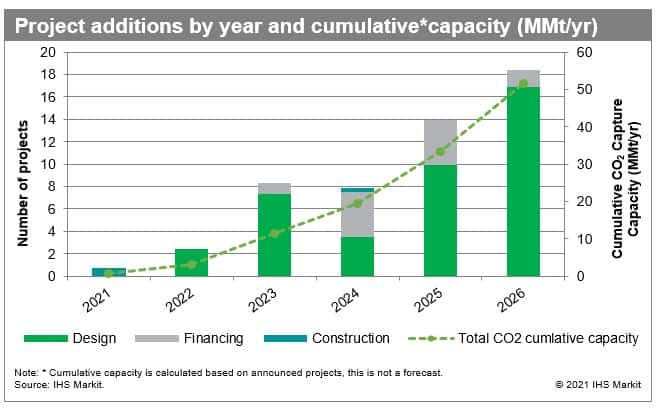Blog: Large-scale carbon capture, utilization and storage projects will need to at least double every five years in order to meet net-zero goals
Net-zero emissions targets and decarbonization ambitions are driving demand for carbon sequestration solutions. CCUS covers a group of technologies that capture and compress CO2 from large point sources, including power generation or industrial facilities, and store it securely underground or transport it for use in other applications.
Most energy transition scenarios estimate that a diversified portfolio of low-carbon solutions will be needed to meet climate goals. CCUS is one of these solutions and is projected to reduce between 4% to 20% of global CO2 emissions by 2050, according to some forecasts. To achieve this goal, the industry will have to grow at least 52 times from its current size - a historical rate of growth for an industry that is still in its infancy. This means that to provide the emissions reduction from Carbon Capture, Utilization, and Storage (CCUS) envisaged in net-zero scenarios, capture capacity will have to at least double every five years for the next 30 years.
IHS Markit's recently launched CCUS Global Project Tracker shows that over the past decade, only 16 large-scale CCUS projects have started operations globally, accounting for 75% of the current operating projects. From these projects, more than half use CO2 for enhanced oil recovery (EOR) which makes for a growth trend in a very niche sector. Over the same timeframe, 20 large-scale projects have been canceled or suspended, mainly from the power sector, largely due to high capital costs and the lack of carbon storage regulation in some regions.
The recent wave of decarbonization targets has activated the pipeline of large-scale CCUS in different sectors. The IHS Markit CCUS Global Project Tracker database includes 23 projects under construction, financing, and design that if completed, could double the operational capacity by 2026 and keep the industry on track to meet net-zero target expectations. There is very limited visibility after that.

Most of the upcoming projects are either in the power sector or the industrial sector and are moving away from the oil and gas industry, which has historically been the lead sector developing new carbon capture projects. Despite the momentum the industry is experiencing, it's important to highlight that most of the projects in the active pipeline are in sectors that have had high cancelation rates in the past.
The high costs associated to carbon capture from the industrial and power sectors has been the main reason for the high cancelation rate. The small number of operating projects, especially in these sectors, make costs estimation a challenging task due to the lack of information and limited scale.
Long-term success reliant on policy decisions, cost reductions and improved efficiencies
Cost estimates vary significantly based on individual plants owing to the diversity in operational conditions and the type of products produced. Parameters such as purity of CO2 stream, capture technology, plant size, process design, plant utilization, energy prices, and location will have a direct impact on the project economics. As the number of CCUS projects increase, there will be a cost reduction, mainly in the capture segment, driven by next generation technologies and learning rate from process optimization, which could further accelerate the growth rate of the industry. A better understanding of these parameters would improve costs estimations of upcoming planned projects.
The next five years will be critical for the success of CCUS as a key decarbonization tool to achieve net-zero. Although it seems the industry is on-track to double global capacity in the next five years, most of the announced projects are still in early stage of development, with 85% of projects in the active pipeline in the pre-FEED phase. Thus, it remains to be seen if the nascent CCUS industry will be able to maintain the substantial rate of growth in line with current net-zero scenarios, and overcome multiple challenges - most critically to secure financing. Further research on technology and costs is critical for the development of new business models required to attract long-term and high-CAPEX investments for the industry to move forward.
To understand the topic of carbon sequestration further, including its opportunties in the power generation and industrial sectors - register for our upcoming Carbon Sequestration Webinar.
This article was published by S&P Global Commodity Insights and not by S&P Global Ratings, which is a separately managed division of S&P Global.


